My art room is stripped bare, supplies sorted and cupboards cleaned. The last thing I want to think about is pouring paint and cleaning brushes but summer can be a great time to test out new art lessons and even make a few bucks with a summer art camp.
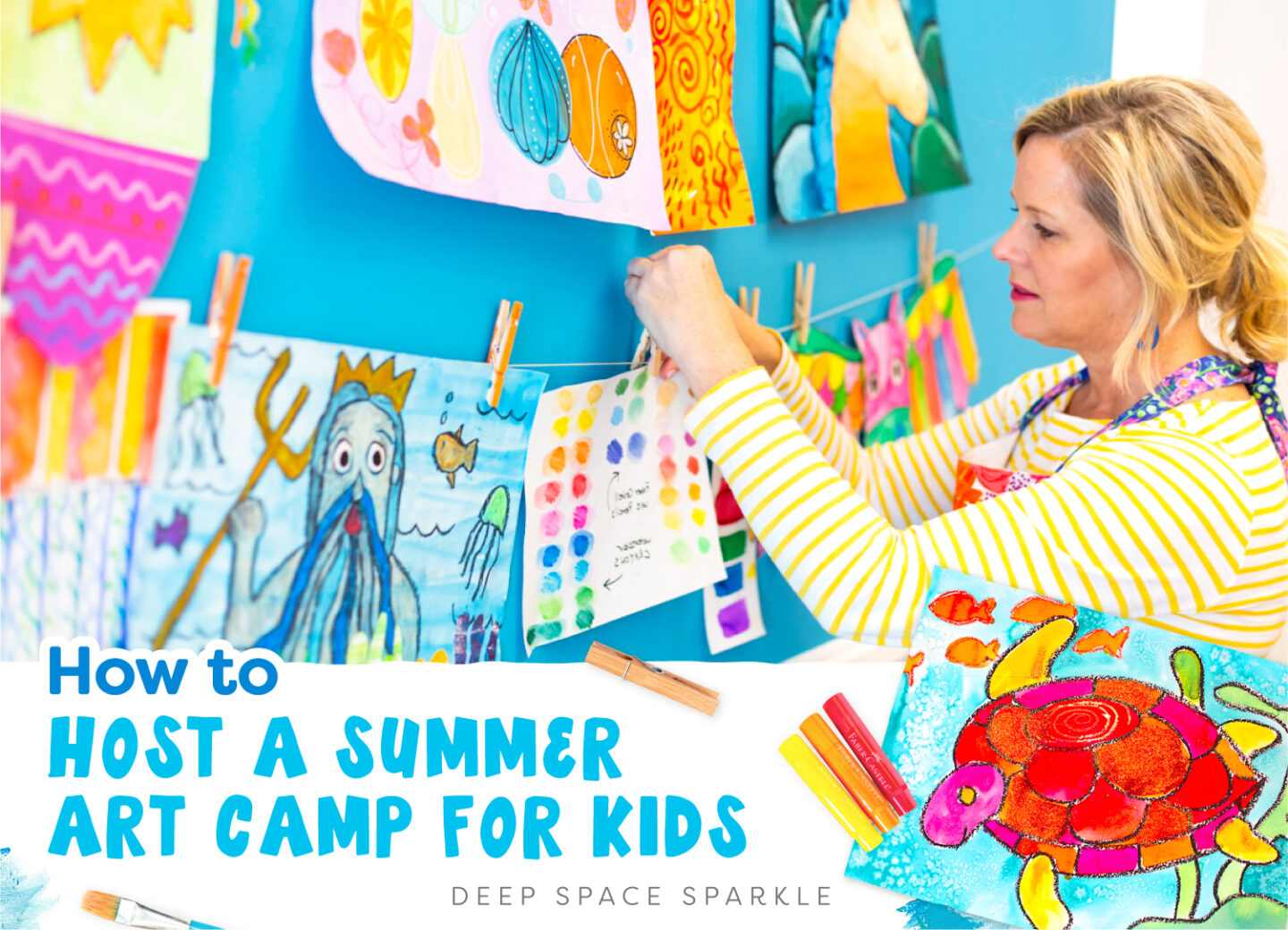
Use these tips to generate ideas to turn your expertise, talents and love of art into a summer art camp business that you may want to do year after year.
1. LOGISTICS
The first thing you need to do is to determine what type of space you have, how many students you can host and how long you want to make the sessions.
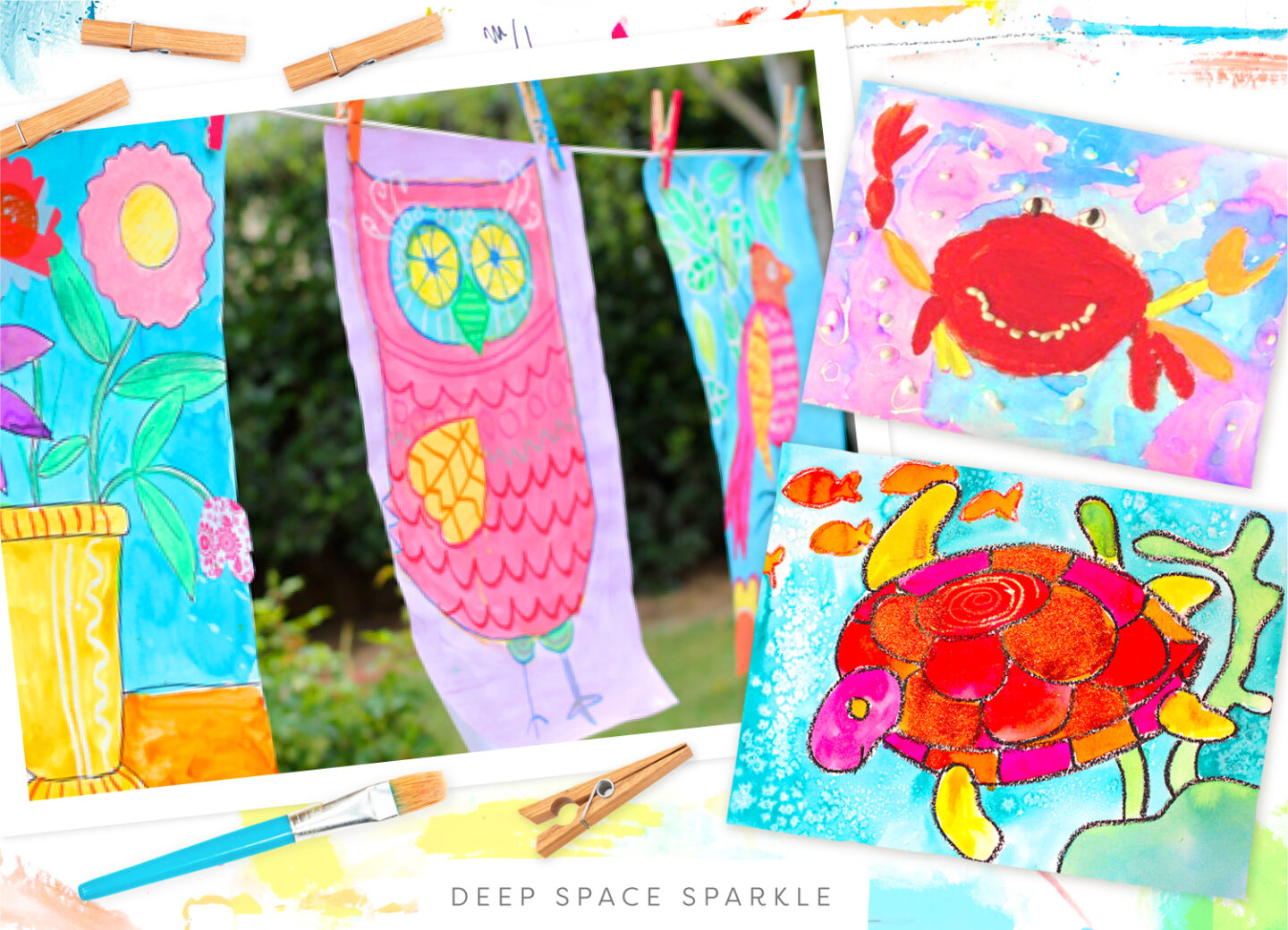
Here are some things to think about in terms of your summer art camp plans:
Space
- Be creative with your space. You can go beyond your kitchen table and head outdoors if you live in an area with little rain threat (hello California!). Set up a picnic table, cover with a plastic table cloth and you are set. If you have access to a sun canopy, use it!
- Connect a string to a couple of trees, buy some clothes pins and you have an instant drying rack. To go a step further, tie the clothesline or string closer to the ground so children can hang their own art work.
- Have a dining room? If you are anything like me, you probably won’t be using your dining room until Thanksgiving so give it a little make-over. Remove your good dishes from your hutch, line with craft paper and fill with your summer art supplies. Remove side chairs or decorations that are too precious for paint splatters and store in a spare bedroom, in a closet or a garage. Basically, stash the good stuff until art camp is over then spend a few hours converting it back to a dining room once the kids vacate.
- Take it one step further and remove your dining room or kitchen chairs and replace with inexpensive stools from Ikea.
- Go to a home store and buy a padded table protector. Cut to the exact size of your table. Cover with craft paper and start drawing & painting.
- Taking it inside is necessary in rainy climates and if you don’t have a spare bedroom or dining room to convert, think about creating a studio in your basement or garage. I like the idea of a garage studio as you can open the door on nice days allowing lots of sunshine and bright lights to infuse the art. Use a decorated backdrop to hide any junk, laundry areas or tool benches that you may not want your campers to see.
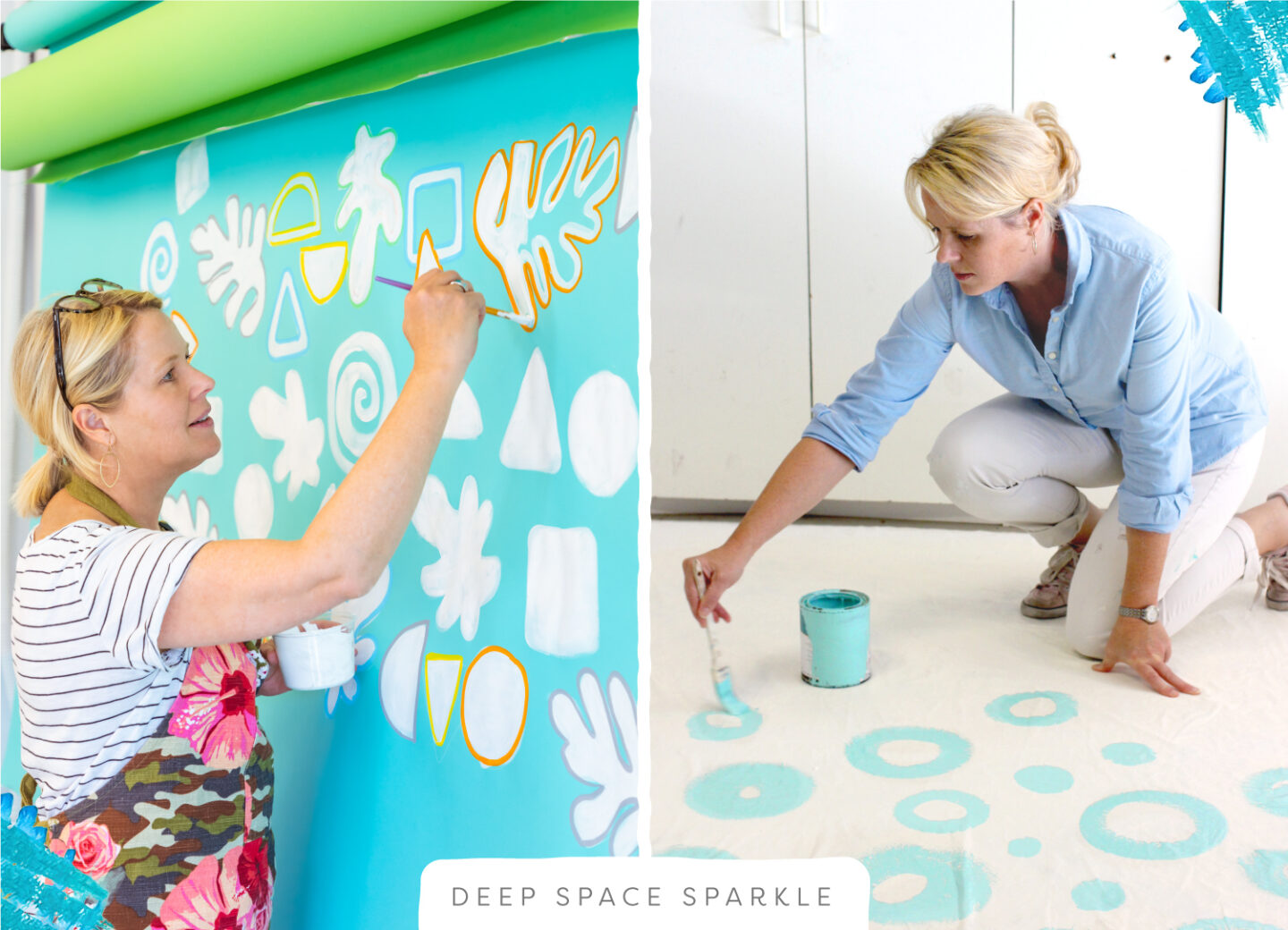
- Consider painting an old flat sheet or length of fabric with latex paint to create a fabulous backdrop for your studio. If you take pictures for your blog, this painted background makes everything look a little bit prettier. I used a double wide length of sheeting and painted with a latex primer. Then, using latex paint from a household project, I created a simple background of swirls and dots. I hang my backdrop on my wall using thumbtacks. No need to bring in the husband for this job. The simpler the better.
- Do have a clubhouse in your neighborhood? These facilities can be perfect for art camps. They usually have tables, chairs and a kitchen available, so it eliminates the need to rent furniture. If you book early enough, you can block off a two-week window for the summer.
2. FEES
You may or may not want to charge for your art camp or art classes but I certainly hope that you will consider doing so. Unless you are brand new to teaching art and you just need some experience for your portfolio or resume, you should absolutely charge your attendees.
How much should you charge?
This is a sensitive topic and there is a great deal of psychology behind it. Here is my take. You must make sure you charge enough to cover your art supplies and snacks, but also cover a good weekly rate for yourself. A good rule of thumb is to charge just a teensy bit out of your comfort zone. You need to have a minimum number of enrolled students to cover your expenses but aim for as many students as you can without affecting quality of service.
Many parents are very happy to pay for a quality art program. If you charge $125 for 20 hours of art instruction, that is only $6.25 per hour. Sounds crazy but if you teach 6 kids, your rate goes up to $37 per hour. Parents don’t think of this hourly-rate when deciding about how much they can afford. They generally look at the broad picture and how much value and convenience you are offering on a weekly scale.
Charging more than $125 (which is just a number I am throwing out there) is entirely possible. The older the children, the more in depth you can create your program and the more you can charge. Of course, you need to make sure you are offering professional and personal service. This means, you should be very prepared, know what lessons or projects you will be teaching and have a good handle on managing different behaviors to ensure that all students get the most out of your program.
Can you do that?
Of course you can!
I can tell you one thing. If you are not paying yourself well enough, you are sending a message that you may not be worth it. If you charge $40 for a week long art camp with 20 kids, parents may assume that you are running a play date not an art camp. Of course, if this is what you want, then do it.
Here is some math:
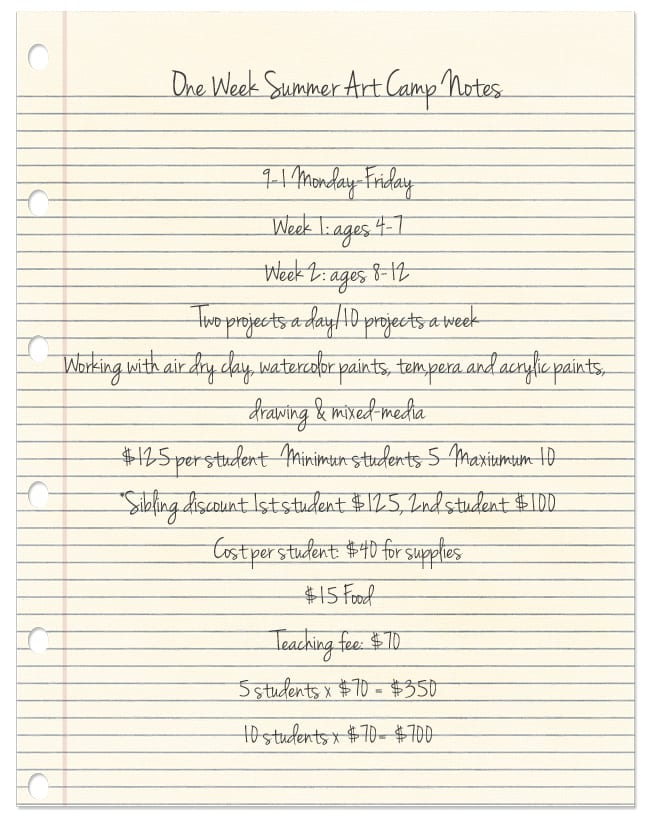
You may want to charge even more than my example. Check comparative fees in your area by doing a bit of research. Look online or call art studios and museums to find their weekly rate. Remember that museums and art studios can accommodate a larger number of students so don’t be afraid if your prices are on par or a little higher. If you have been teaching art at a local school you have credibility and authority, so take advantage of it.
Be confident that you are offering enriching art projects. Conduct your art camp–even if it is at your kitchen table–with enthusiasm and professionalism. This means having art projects that are aged appropriately, use quality art supplies and offer a variety of instruction.
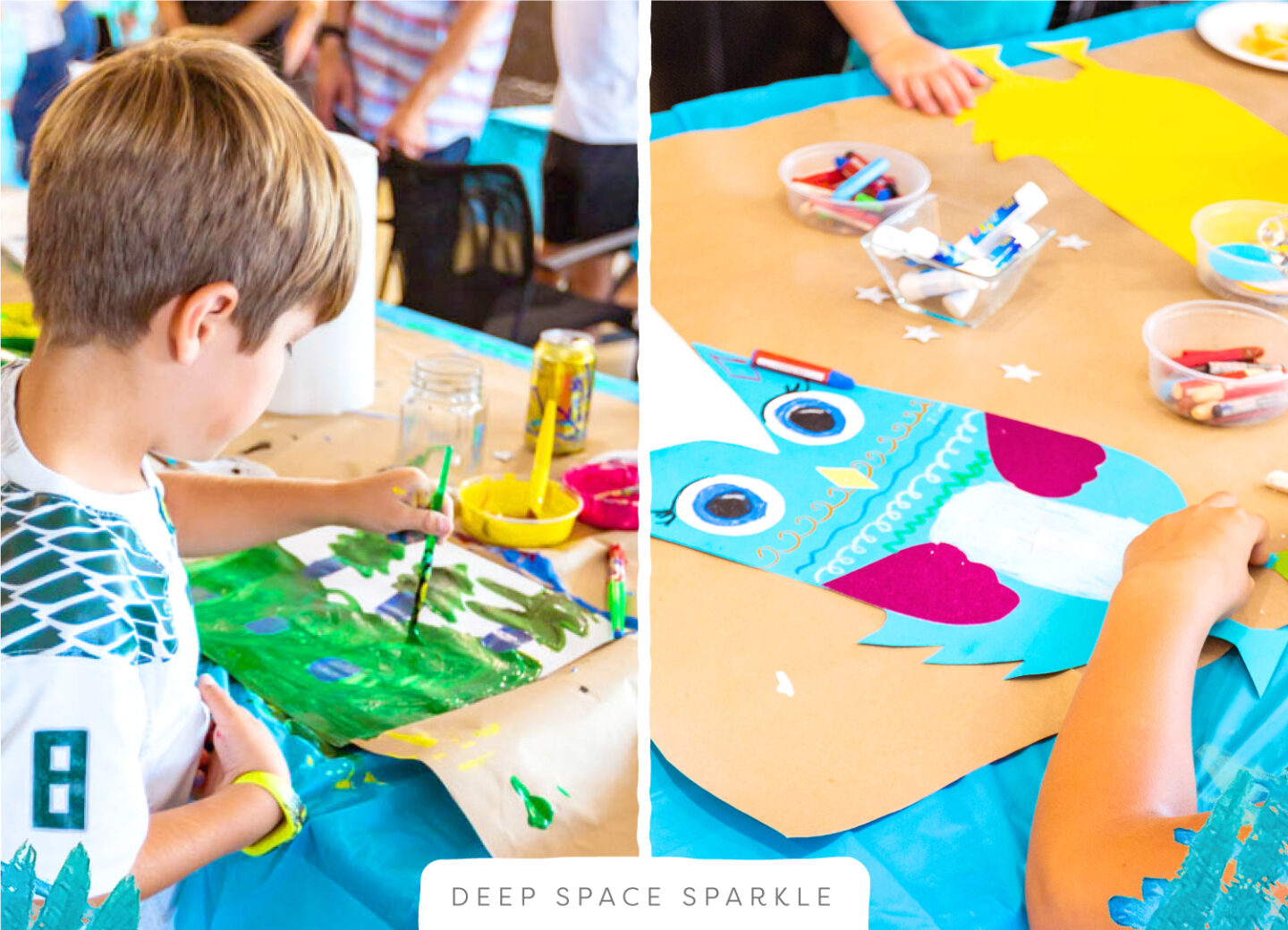
3. AGE GROUPS
How wide of an age range you accept depends on your own comfort and situation. You may be the mother of two kids ages three and seven. Of course you’ll want to include both ages in your art camp and one way to do this is by getting some help. Managing ten, 7 and 10-years olds is a lot easier without preschoolers in the mix. Their attention span will just not be as long. I would consider hiring a high school art student who loves kids to be your assistant and emergency babysitter to the 3-year old.
The best situation is to create different sessions for the different age groups. I like to divide the kids into two groups: 4-7 and 8-12. The children within these two groups can do many of the same projects.
Combine Efforts
Another way to increase profits, offer a valuable community service and engage the kids for a longer period is to team up with another professional. Perhaps your school PE teacher or music teacher would like to create a camp with you. You could do art with the first group in the morning, and art with the second group in the afternoon, while the other teacher creates her own music or PE camp during the alternative times.
Or even combine efforts with another art teacher–they do upper grades and you do lower grades.
Here’s what a summer art camp day could look like:
9-12 Art for Group 1 (ages 4-7)
9-12 Cooking Camp for Group 2 (ages 8-12)
12-1 Lunch for all
1-4 Art for Group 2 (ages 8-12)
1-4 Cooking Camp for Group 1 (ages 4-7)
4. LEGALITIES
Check with your State to see if you need special licensing or insurance for your summer art camp. States differ and many are dependent on how long you run your camp.
If you keep your group small, you may be covered under your home-owners insurance.
You can establish a business name for your camp, but it’s not necessary for tax purposes. Simply keep your expenses and earnings and file as a sole proprietor.
If you have a neighborhood clubhouse, and are planning to use it for your camp, they usually require a copy of your household insurance. At least that’s all mine requires.
5. ADVERTISING
A few years ago this would have been your biggest hurdle, but now with social media, you can target parents of children in your immediate neighborhood with Facebook ads. Of course, you probably don’t need to advertise at all. You know many children from school and through your children.
If you have some creative energy you need to unleash, I would suggest making a poster. Make it colorful, easy to read and include all important information (name of camp, when, contact info, maple of projects).
PLANNING YOUR SUMMER ART CAMP PROGRAM
Once you have determined the age range of your summer art camp kids, you can plan your curriculum. The art projects you do depend on how many art mediums you want to tackle. You can stick with drawing & painting projects, a combination of mixed-media lessons and clay, thematic units or even a combo of art & crafts.
I would opt for trying as many mediums and subject matters as possible because you want to ensure that all students love at least a few things in the camp. This is also an opportunity to offer children the opportunity to work with materials they might not get a chance to work with like acrylics and canvases or clay.
SUMMER ART CAMP PROJECT IDEAS
I have compiled a long list of art projects according to techniques and art supplies.
Keep in mind, this PDF contains project ideas and lesson links not actual lessons. Use the list to generate your own summer art camp program and create a balanced, art technique-rich camp.
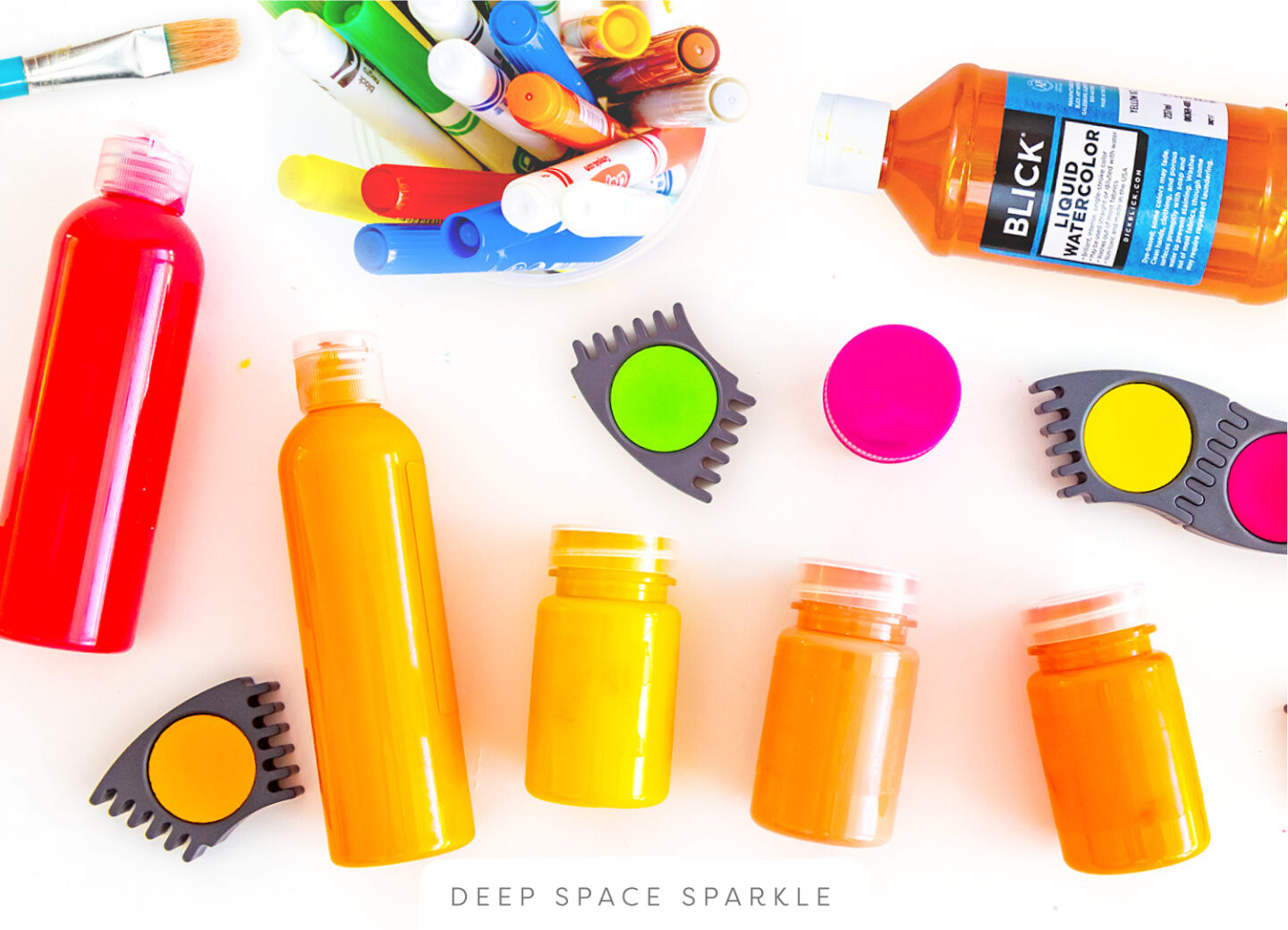
What art supplies you order depends on what lessons you tackle. The art projects in the download use inexpensive supplies that are available at most art stores or online vendors.
Here’s what you’ll need for a 2 week class of 5-10 kids
- Drawing & Painting Paper: I love the 76 lb Tru-Ray Drawing Paper. It is a perfect weight for drawing with pencil, oil pastel and painting with tempera paints. Buy 8-10 packs.
- Watercolor Paper: Buy the cheapest school-grade paper you can find. Children draw with crayon and oil pastels on watercolor paper and it’s easier to draw on a smoother surface. Expensive papers tend to have a highly textured surface which isn’t necessarily what you need for children’s art. I like Canson’s Watercolor Paper Packs. Buy 3 sheets for each child assuming you’ll do 2-3 watercolor projects. The 100-sheet pack of 12″ x 18″ is less than $50 so it may be worth buying in bulk.
- Tempera Paint: I love Crayola Washable Tempera Paint and have used it almost exclusively in my art room since I began teaching. I recently tried Faber-Castell’s Connector paints and they are very, very nice. Unlike Crayola paints, they dry to a smooth, non-chalky finish. Buy 1 container for each primary & secondary color plus 3 whites and 1 black.
- Cake Tempera Paint: Cake tempera paints are the paints that look like big blocks of watercolor paints but they have an opaque finish. They deliver a lovely painting experience but tend to dry to a chalky finish. Still, they are a great paint to have with young kids and classrooms. I’ve heard Alphacolor Biggies are great, but I have only used the Blick Tempera Paints. They work great for me. Buy 3-4 sets so kids can share.
- Brushes: A good brush makes all the difference in kid’s art. The brush should be soft, yet firm and have a good quality handle. This doesn’t mean you need to spend a lot of money. I love Royal Langnickel Big Kid Choice Brushes. They have a variety of brush sizes and tip options so make sure to scroll through their options. I buy the small, medium and large round tip brushes (green plastic handle) plus a medium and large flat tip brush (red plastic handle). If you were to buy one brush, make it the round size 8.
- Oil Pastels: I buy Sakura Oil Pastels. They affordable and don’t smudge when wet. They also allow me the option of buying individual black and white which I use in abundance. Buy 12-24 color sets multiples by the number of students.
- Chalk Pastels: The best chalk pastels I have purchased were the most inexpensive. I love the classroom pack of Sargent Art Square Chalk Pastels. They do kick up some dust but I love the rich color they produce. Buy 12-24 color sets multiples by the number of students.
- Watercolor Paint Sets: I love the refillable 16-color sets from Crayola. Or try the Connector paints from Faber-Castell. More expensive but amazing quality. One tray per student.
- Liquid Watercolor Paints: If you love painting with children you must purchase liquid watercolor paints. You can read why I absolutely love them HERE. I don’t favor any particular brand as they do seem quite similar. The Blick Liquid Watercolor Brand does give you the option of buying a small 4 oz jar, which is great when you just want to try a few. Buy a few 4 0z bottles in the following colors: blue, turquoise, red, green, yellow.
- Markers: Crayola Broad Tip Marker for budgets and classrooms and Prismacolor Markers when your budget has more wiggle room. Buy a big set for kids to share.
- Air-Dry Clay: Crayola air dry clay is especially good for young hands as the clay is very soft. Tall shapes don’t hold up too well but anything slab-created works well. I love Laguna air dry clay but it is more expensive. Still, you don’t need much to create some really beautiful pieces.
There you have it! My ideas to help you generate some fun and income for a summer art camp in the hot summer months ahead. I’d love to hear from you.
If you have ever hosted a summer art camp of any kind, please share your links and ideas in the comments below.
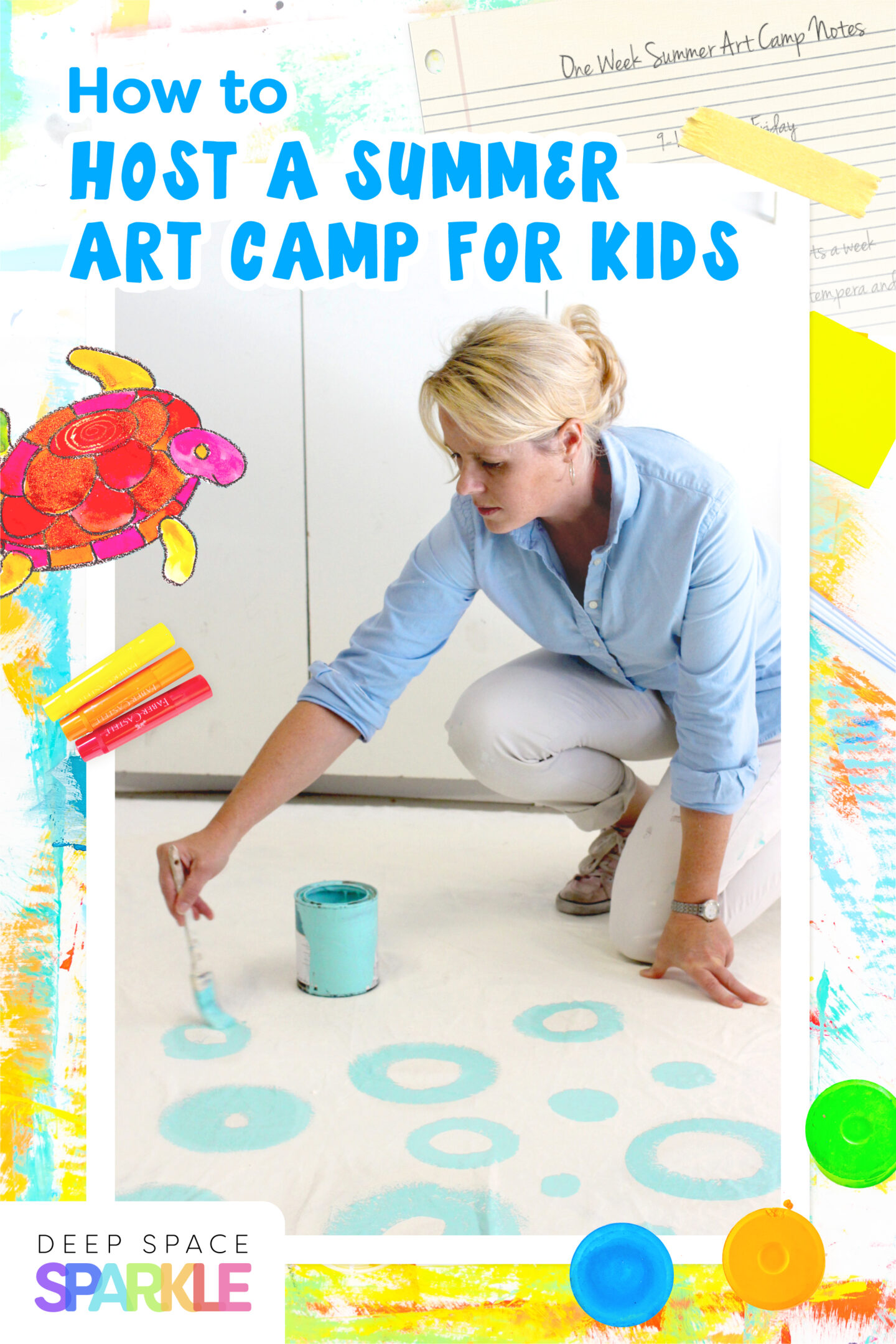

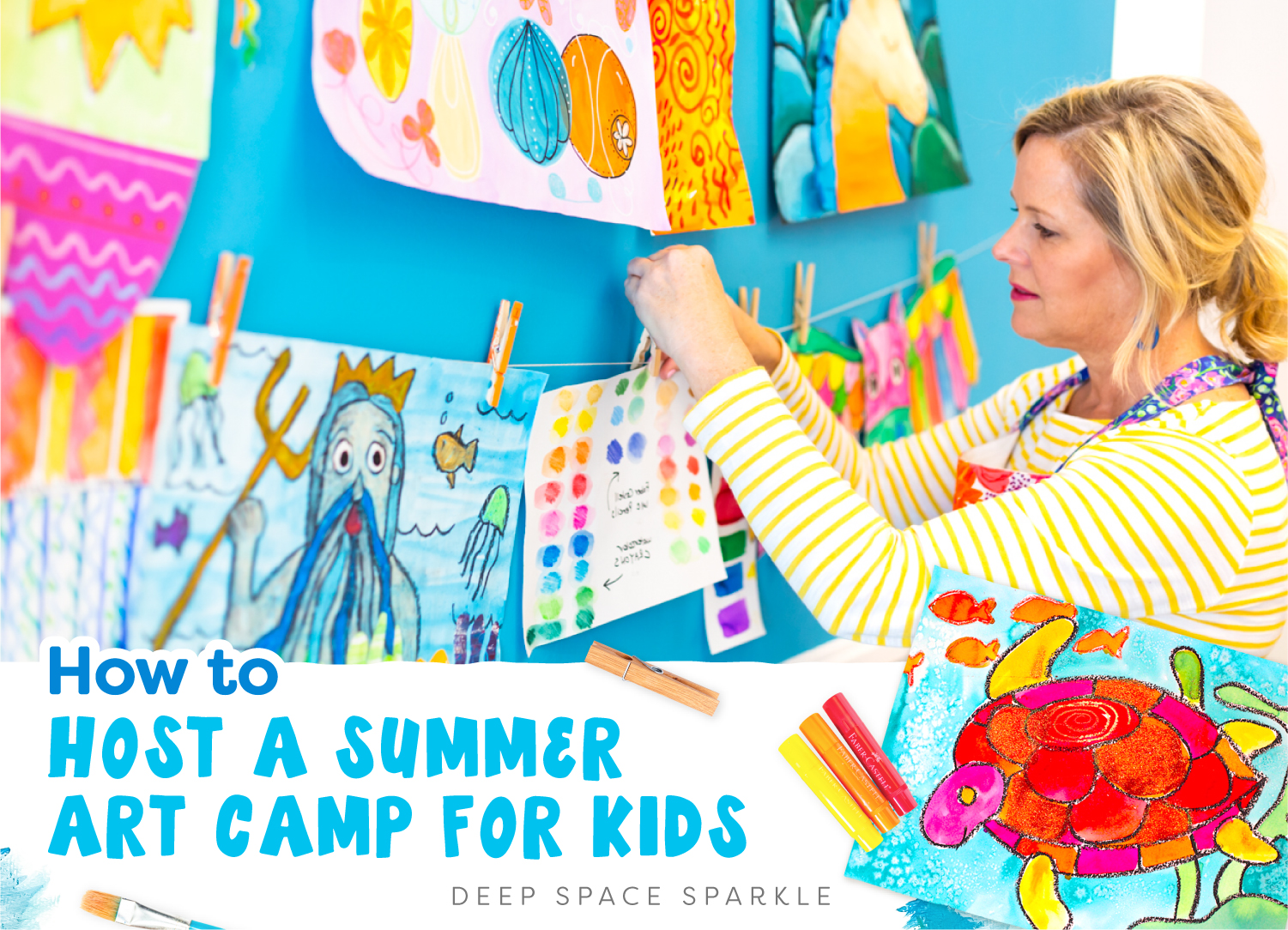












This is great! I actually am doing an art camp for the month of July and these are all things I had to think about. But, when considering my space I did not think to have a place to hang their work. I will definitely modify something for next weeks camp. Thanks!
thank you for offering such good advice. I am so encouraged when talented and experienced teachers are wiling to share and mentor other aspiring art teachers.
PS – I am a homeschool mom and have offered smaller events (art projects, sewing,cooking) in my home.
I just went into an art studio and have room for classes and want to teacher childern however I am a grandmother So don’t have any little ones at home anymore so how do I get childern students? Would appreciate any ideas you have. Thanks
Create a flyer or mini-poster and distribute on a church bulletin board, local YMCA or any place that offers community outreach. You’ll need to create a list of friends and family who could help you distribute flyers and spread the word of your art camp. Don’t be shy. You may just be what a local neighborhood mom needs for a few hours rest on weekdays!
Good luck.
I am passionate about art and literature. Planning to start similar camp for kids. Thank you for the inputs. I like your s xtuff.
Can you tell me how do you decide what to include in the camp?
Do you make all your art work yourself first?
Do you return kids artwork on day to day basis?
You are so good at art. God bless. Keep doing the good work and thank you for sharing.
Hi D, do the art first. This way I know where some glitches or slow parts might happen or where kids may struggle. You can decide to return the work each day or you may want to hold an art show at the end of camp (that’s what I would do!)
Great questions. First you need to decide what age groups you are serving and what type of art you are good at teaching. Some people like clay others drawing and others a combo. Make sure to read the second part in the series and download this PDF. https://www.deepspacesparkle.com/shop/art-camp-guide-project-ideas/
I
Have fun!
I’ve been teaching summer art camp out of my back yard studio for nearly 20 years. I also teach at two public schools. I like them both, but camp is heaven!!! I did it without a license for years (I’m in California) but a neighbor called the authorities so now I jump through hoops and have a home day care license. There is no “summer camp” license so I just have to follow the rules of childcare licensing. That means a limit of 8 school age children. I could go bigger (up to 12 students) with a 14 year old helper, but it would require some building changes and I’ve decided that what makes my art camp unique in this area (that has a whole lot of fabulous art camps!!!!) is that my program is really intimate. Each camp week has a theme (Famous Artists, World Art…) I see the kids from 9-3 Monday through Friday and we use excellent materials and end with an art reception where each student talks about one of his or her pieces from the week.
When I started I did it with a friend and we ran a winter holiday gift making camp. No internet then, but we spread flyers around and didn’t charge much. That got the word out and my camps have been quite well attended ever since. I have learned the value of my work and charge a lot of money for a week of camp. I do feel a little conflicted about the high price, but I know what I offer is a truly special experience and I also teach a much more diverse population throughout the school year.
I feel blessed by the success of my program…. I am pretty passionate about it. And, I remember back to 1995 when I tried to offer an after school class and no one signed up. Not one person! But it was only a few months later that I did the holiday camp. Then a parent asked if I could offer a camp in February if she found me some students. Now I set my dates in January and fill by lottery. So, if you are passionate, try it and stick with it. Your enthusiasm will surely attract more success.
Thanks so much for these great tips!
Hello, I work at a school with 5 year olds as an asst. I have been wanting to teach art camps during the summer, but have no idea how to get started, you sure gave me a lot to think about, and I am ready for this summer to start teaching my art,
Lucy what do you charge for your art camps. I teach in a public school a whole lot of students per week…..I am getting my art camp started this summer in my 500 square foot art studio in my backyard….Just needing as much input as possible.
Oh, and one other thing…. I used to try to figure out what my prospective families wanted regarding scheduling and age ranges. I learned that I had to get clear about what *I* wanted to offer and trust that it would work out. That way I can more joyfully do what I do instead of trying to twist myself into what someone else wanted (or I thought they wanted).
I have taught many hours of art camp to ages 4-15 . A few things I have found that work well is to have one ongoing project first thing as they are arriving and at the end of class. Its something relaxing and not needing alot of instruction like hola hoop weaving, creating art trading cards even a journal. I also will use web cam sites late afternoon they work to re focus after a big exciting art making, only if its fits ie tug boats, lots of bird nesting sites and the otter cam if doing a sea life theme is always a hit. And I always finish up with some sort of exhibition at the end .
I have an unusual situation, in that my students for art camp (a volunteer-run camp at a homeless shelter) may not be the same from week-to-week. It’s really important that I have projects that can be completed in a single, one-hour session. Obviously, projects that appeal to a wide range of ages and abilities are necessary, too! I do have a number of ideas–many from your classes and lesson plans, like the O’Keefe watercolor flower from the Basics class–but do you have any other fool-proof favorites that can be done in such a short session?
I hear ya! I have a category in my Art Library called 45-minute lessons. Here’s the link: https://www.deepspacesparkle.com/category/45-minute-art-lessons/
Hope some work for you. Love what you are doing. Keep it up!
Just what I was looking for! Thanks!
I have wanted to start a summer camp for a while, but was unsure of the focus. You have just given me my answer! I LOVE art and love to teach it to my homeschooled kids. They just came out of an art camp where I was greatly disappointed by the projects they brought home. Of course, I didn’t tell the kids that! 😉 It wasn’t that their work wasn’t good, it’s just that the projects weren’t good. I have done much better projects here at home in our homeschool than what the camp offered.
I am going to run a ‘mock’ camp this summer to get a feel for it, as each year the cousins all come together at our house. Your ideas have given me much inspiration! THANK YOU, so very much.
I love your site, your projects, and your suggestions. I have recommended your site to many other homeschoolers (Especially those that say they could never teach art!), as your lessons are so easy to implement and they always have such fun, beautiful, and creative results.
Gratefully,
Anne 🙂
I have been running successful art camps from my home for the past few years. They are fun and very profitable. I would HIGHLY recommend offering half-day camps if your area has parents or nannies at home with the children. My camps run for 2.5 hours from Monday to Friday. That gives us enough time to do a great art activity (or two depending on the age group), have a small snack, and play some camp games. It also lets me offer two camps each day to different age groups and have time to set up for the next group during my lunch hour break. I can focus on the “teaching” part of art and less a daycare or babysitting feel.
Jennifer what do you charge for a two hour session? I am starting an art camp in my backyard studio and like the session camp time slot idea….
Some popular camps have been….
Paint and Pastels
Drawing and Design
Graffiti Art and Cartooning
Mastering the Masters
Kinder Art
You can probably guess which gender signs up for each one!
Hi there, do you have any more information about your Grafitti Art and Cartooning? The children I teach are always asking me for a lesson on Grafitti! Any top tips much appreciated! Thanks! Jo
Hi Jo,
While I don’t teach graffiti, check out the art of Keith Haring. He started out as a graffiti artist!
Great to hear about all these ways of running art camps. This summer I had my first two outdoor art adventure camps. My idea was to take the kids outside on a walk to the woods or the local park, to explore with pencil and paint. Everyone had their own quality sketch book and we went outdoors every morning and then returned about 1’ish for lunch and so continued to work in my studio up until 3 o’clock. It was such a good experience for everyone and even with the Scottish summer being very reluctant and cold doing stuff outdoors was so inspiring. At the end of each camp the kids brought home their sketch books.
Charlotte Anker
Preparing for my first at home art camp this summer. I have been questioned on where there is a good art camp by so many parents as the art teacher. After some encouragement from my co workers I have decided to take the jump. I am busy planning and purchasing all my supplies. I have slowly advertised to parents that know me very well and trust me. God has slowly proven this is what is what I am to be doing. As of today I have 9 students in my 5-7 and 7 in my 8-10. Those numbers are perfect and I am happy where it is going. I will have to give an update on how it went. Thanks for all the advice!!
Congratulations Brannan! This is so awesome to hear!
I love your owls and birds that are hanging on the line in the ‘Hanging Artwork’ section! I can only find an owl project for younger children – do you have any more examples of the pictures above?!
Fingers crossed.
Many thanks
Jo
Thank you so much for these helpful ideas!
What have you found to be the ideal size for a camp size? I am thinking about teaching 15 (if my school allows me to use my classroom), do you think that is too many to charge $125?
How long do your classes run?
Do you have any sort of permission slip that you have your students fill out? I am almost positive that my school will allow me to use the facilities (we are a small private school), but am nervous about the liabilities that could fall on me.
Thanks for your advice!
Thank you so much for all this information! I have been wanting to do an art camp for such a long time, I believe that this year I will be able too. With this info, I can’t wait to start planning!
Hey Patty,I have been wanting to have art camps ever since the studio in my backyard was finished but haven’t yet. I am planning on this summer.
I noticed that you added a teacher fee and a supply fee for your art camp idea possibility… I like that is is separated out, then included… Do you add that to the 125 then the 40 for the supplies? I am just trying to get as much info and possible ways to do this in my head. I teach a whole lot of kids each day… 8 classes most days with 25 students all ages… I am excited about having fewer students where I can offer really nice supplies combined with excellent projects.
Hi Ann,
This post is a bit old and I don’t know if people come back and check on their responses, so I have a suggestion. I have a free FB group for Deep Space Sparkle where conversations like this happen. You can join here:https://www.facebook.com/groups/DSSstudents/
Or if you are a member of The Members Club, the group is very active and there are hundreds of studio owners who do what you want to do in the space. The conversations and support is very high. To sign up to be notified of the next enrollment, click here: https://deepspacesparkle.leadpages.co/join-the-mc-wait-list-post/
hi,Patty,i am in California,Orange County,i want to hold a summer camp in my garage,do you think i need to buy a special insurance for camp?thank you!
Your home insurance will probably cover this but you should always call your insurance company.
Wow!! This is amazing and exactly what I’m looking for!!!! Now to find the courage to just DO IT!!
Hi! I am a part time art teacher and I host traveling paint parties as well. I have done summer camps before, but I am looking to take it to the next level. Thank you so much for this information. It has encouraged me and given me much insight. God bless! =)
It must be pretty difficult to run an effective art camp for young children, so it is nice to get an idea of what you’ll need. I think it is particularly great that you bring up brushes as a big thing. After all, you’ll want to make sure that you have plenty of paint brushes for the kids that you will be teaching. https://tc-artworks.com/classes
To display art, I bought three 2′ x 4′ sheets of pegboard. I connected them with zip ties into a Z shape, which self-supports and could also be a U or a triangle.
I strung yarn in a zig-zag from front to back. Across the top, then at an angle of across+10 holes lower. This makes many “clotheslines” to clip art with clothes pins on both sides, for six surfaces.
I also have Travel Spirograph which uses sticky notes that I just apply to the boards directly.
I am a new art teacher and have been asked to run arts and crafts workshops for children aged 6-12 for 3 hour sessions. The maximum amount of children is 30 which I think is too high, hoe many would be more realistic?
As long as you have a helper for the younger kids, i think this would be fine. Bit of you are complete new to teaching art to kids, it might be overwhelming. You can always start with a lower enrollment and add more kids of you are feeling confident. Hope this helps!
I love the idea of hosting a Summer Camp for Kids. It sounds like lots of fun and great experiences. i will seek to do one next year 2019.
Thank you for offering some sound advice. In addition, the list of supplies.
Thank you for that information, I am a retired art teacher and have done art camp in our federal park and they won’t allow me to charge a fee, I have to figure a way of getting around it, I love your ideas and how to figure out a fee to charge.
We’re offering a 3 hour class (for 5 days) for kids with a snack half way through. One snack will be a peanutbutter substitute with jelly. We’ve found that Sunbutter is indistinguishable from the real. (parents are told about it.) We have a business already so location, insurance etc. is all taken care of.
Do you give the kids a “starter kit ” so they’re able to create at home? Or is it just materials to work on in camp?
I would only give materials to work on in camp if that’s what your focus is. Otherwise, the need to come to class is lessened.
This has been supper helpful. This will be my first try. Thank you so much
Excellent and thorough information! I can’t wait to plan my first Art Camp!! Thank you for the ideas and guidelines which insures me confidence to provide educational, fun instruction for all age groups!
Hello Patty,
This is amazing information, it brings up a lot of points that most people don’t even think of! As someone who works with a lot of camps, I’ve found there to be a disappointingly low amount of art camps in most states. I hope that changes and if anyone needs any help with ideas for how to run an art summer camp I’ll definitely point them to this article.
Thank you for sharing your knowledge and experience. Your ideas are great!
This is awesome!! I will try and do anonline class
Great Info…Thank you!
love it, kids will too
Thank you for these tips! I’ve been running a summer art camp out of my garage for the past 18 years and love it for all the reasons you list above. I can try projects with a smaller group of kids, use materials I don’t usually use in my school art room, and you can’t beat the commute! After a few years, returning campers and word of mouth advertising make it very easy to fill the sessions. I’d also suggest having parents sign a waiver and/or emergency form. I’ve never had an accident or issue, but I like to be prepared.
Hello!
I am planning my summer camps and this came into my inbox at the perfect time! I plan on using several of your lessons for my “Around the World With Art
themed camp. Just wanted to mention that at least 3 links in the PDF are not working… also, I am trying to figure out what lesson the image of what looks like printmaking fish goes to?
Thank you!
Hi Christina! I’m so happy that you found this helpful! I just tested all the links and everything worked for me. Something we’ve found is that Firefox tends to have issues with the site, so it might help to switch browsers. Chrome and Safari work great! Another thing for us to try is to clear your browsing history, cookies, and cache and restart your computer and try again.
The fish lesson is call Fish Printing Project. I’ll include the link to the directions below.
https://www.deepspacesparkle.com/fish-printing-project/
Enjoy!
Thank you so much for the fish printmaking project. This will work well for my Around the World Art Camp! I should be more specific in explaining that the links go to your website but then it says “page not found” on the DSS site. And it is in Chrome. I also tried downloading the PDF and opening in Adobe. One example is the Modern Masters 4 Art Lessons.
But if it is an error on my end, that is AOK. I have enough for camp!
Thanks for this material ! Since my retirement from the classroom in 2011 I have been running arts and craft camps. I love it! I work out of our local community centre. We are a rural community in cottage country so I get aspiring artists from here and urban centers. Your site is always inspirational !
great tips, thank you
I teach in a private school and am able to use my own classroom for the camp. I love it! I teach one week Monday-Thursday 9-12 for rising 1st -3rd grades and then 1:30-4:30 for rising 3rd-6th. I have about 20-24 students in each session. I also hire a college age assistant to help me. We do papier mache, oil pastels, watercolor, and a canvas painting. Kids bring their own snacks! We all have a super fun time!
Is there a way to purchase just an art summer camp program?
Hi Jessica! We don’t have an individual summer camp program. We have lots of lessons that would be perfect for summer camp. All lessons are only available inside The Sparklers’ Club Membership.
Love the excellent ideas.thank you
i got a lot more ideas to start an art camp. Am an art teacher by profession and planning to start an art camp soon. Thank you so much for your valuable suggestions and ideas. It was of great help.
thank you so much for al this valuable information! i’m just starting to offer art camp for the holiday school breaks to all my friends’ kids. this helps a lot!